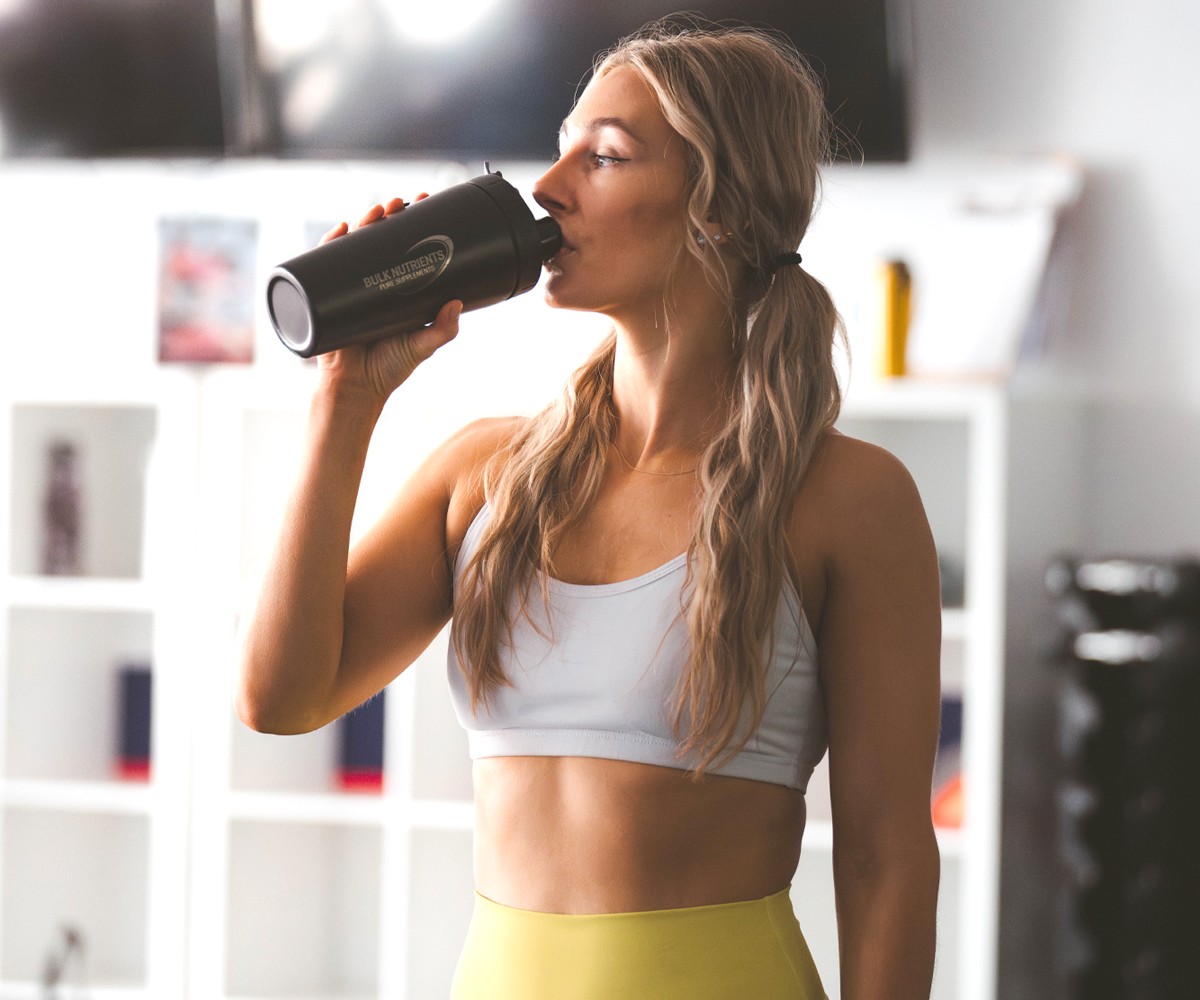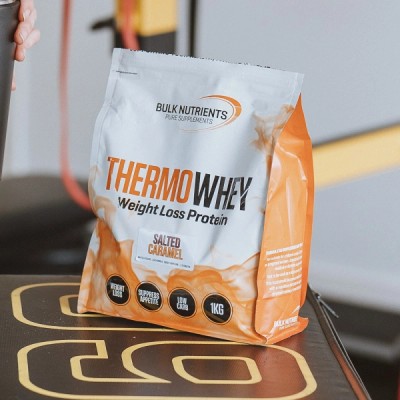How to Lose Weight (And Preserve Strength) Without Doing Cardio

How to lose weight: implementing a calorie deficit.
At a basic level, weight loss comes down to these three things:
- Knowing the number of calories you burn roughly every day; what’s referred to as our TDEE (total daily energy expenditure).
- Ensuring you’re in a 10-20% calorie deficit subtracted from our TDEE, for healthy and steady fat loss.
- Sticking to this 10-20% calorie deficit with the correct ratio of macronutrients for an extended period.
So grab a pen and paper, and we’ll work out these numbers for you together!
Step 1 = Working out your Basal Metabolic rate (BMR). This is the number of calories your body needs for optimal organ functioning. You discover your BMR by multiplying your body weight by 20.
For example, Bulk Nutrients customer Jenny is 75 kg. 75 kg x 20 = BMR of 1500 calories.
Step 2 = Work out the Thermic Effect of Feeding (TEF). This is how many calories you burn each day from what you eat, courtesy of the energy generated by your body to digest it. And you get to this figure by multiplying your BMR by 0.1.
Jenny’s BMR = 1500 calories. 1500 calories x 0.1 = 150 TEF. (1500 BMR + 150 TEF = 1650 calories so far).
Step 3 = Work out the Exercise Energy Expenditure (EEE), which is the calories you burn during exercise. Let’s assume Jenny is doing 60 minutes of weight training, which equates to roughly 216 calories.
(1500 BMR + 150 TEF + 216 EEE = 1866 calories so far).

Step 4 = Work out your level of NEAT. NEAT stands for Non-Exercise Activity Thermogenesis, and refers to how many calories you burn daily away from exercising;
sweeping the floors, fidgeting, typing, chewing gum, maintaining posture sitting at your desk, and walking to the bathroom.
Fat loss: How to work out how many calories you need to eat to lose weight.
There are two major categories for calculating your level of NEAT:
- Category 1: An inactive profession -- (desk job employee) = 250 calories from NEAT
- Category 2: An active profession -- (parking inspector, waitress/waiter, delivery driver, building site worker, etc) = 500 calories from NEAT
Let's say Jenny has a desk job. She’s now looking at: 1500 BMR + 150 TEF + 216 EEE + 250 NEAT = 2116 calories).
Therefore, Jenny’s TDEE is 2116 calories.
Now we need to work out Jenny’s calorie deficit, in which Jenny has three options:
- Small deficit: 10-15% below daily activity.
- Moderate deficit: 20-25% below daily activity.
- Large deficit dieting: 25% below activity or greater.
The bigger the deficit, the harder the diet is to maintain. And the more strength you can lose, too.
According to research, a 20% calorie deficit is a great balance; allowing for no significant strength losses. We’ll come back to this, but in the meantime, let’s set up Jenny with a 20% deficit!
How to calculate your TDEE for fat loss.
20% of Jenny’s TDEE of 2116 calories is 423 calories. So we subtract that from Jenny’s TDEE: 2116 calories - 423 calories = 1693 calories.
This is ideal, as a 500 calorie deficit has always been touted by scientists as a good benchmark for fat loss.
So, we’re left with this: Jenny must consume 1693 calories per day to stay consistent with her 20% calorie deficit.

How we arrive at the below amount of protein, fat, and carbohydrates is beyond the scope of this article, but Jenny’s daily level of macronutrients would like something like this:
Protein: 170 grams (680 calories)
Fat: 50 grams (450 calories)
Carbohydrates: 140 grams (560 calories)
Total = 1690 calories.
If Jenny sticks to this consistently, she’s going to lose weight week to week without doing any cardio at all.
Preserving muscle strength whilst dieting.
So, Jenny is now losing weight consistently thanks to her calculated approach which includes no cardio. But Jenny wants to ensure she maintains muscle strength as best as possible.
First of all, you can see how Jenny’s protein is the highest of all macronutrients. This is because protein allows for the preservation of muscle mass (particularly during a diet) and also because protein is best for keeping you full!
So how much protein do you need daily when trying to lose weight and preserve strength as best as possible? Recent Recommendations suggest 2.3 - 3.1 grams of protein per kilogram of body weight per day.
Given Jenny is 75 kilograms, we’ve set her protein at (75 kg x 2.3 = 172.5 grams) at 170 grams per day.
Whilst strength losses may be somewhat inevitable when you reduce calories, the point of Jenny’s high protein diet is to maintain as much muscle as possible. Moreover, Jenny’s 20% calorie deficit is in line with the previously mentioned study that didn’t record significant strength reductions in the elite athletes studied.

And importantly, given lower reps (ie, lifting heavier weight) is more effective at building muscle strength, that’s exactly what Jenny should be doing during her diet to preserve strength as much as possible. But it must be a balancing act; below is what this could look like:
Sample workout -- Jenny’s leg day:
5 x leg extension (20 reps, 15 reps, 10 reps, 10 reps, 10 reps)
6 x squats (12 reps, 8 reps, 4 reps, 4 reps, 4 reps, 3 reps)
5 x hamstring curls (15 reps, 12 reps, 5 reps, 4 reps, 4 reps)
5 x good mornings (15 reps, 12 reps, 8 reps, 5 reps, 4 reps)
You can see in bold where the sets are in the lower rep range (1-5 reps), This is because research suggests this is the best rep range for maximal muscle strength!
It’s important to keep in mind that lifting too many low reps can be taxing on our system and prolong our muscle recovery - particularly during periods of calorie restriction.
It might be different from person to person, but start with 50% of your workout in the lower rep range (1-5) and shift and adapt from there. This may be a good strategy in ensuring you preserve muscle strength as best you can.
The truth is that you can lose weight without doing cardio, and cardio is not a critical factor in losing weight. You can also preserve muscle strength by training in the right rep ranges, and by ensuring you eat adequate levels of protein in line with recent scientific recommendations.
References:
- Carels RA, Young KM, Coit C, Clayton AM, Spencer A, Hobbs M. Can following the caloric restriction recommendations from the Dietary Guidelines for Americans help individuals lose weight? Eat Behav. 2008 Aug;9(3):328-35. DOI: 10.1016/j.eatbeh.2007.12.003. Epub 2008 Jan 4. PMID: 18549992.
- Cava E, Yeat NC, Mittendorfer B. Preserving Healthy Muscle during Weight Loss. Adv Nutr. 2017 May 15;8(3):511-519. DOI: 10.3945/an.116.014506. PMID: 28507015; PMCID: PMC5421125.
- Falcone PH, Tai CY, Carson LR, Joy JM, Mosman MM, McCann TR, Crona KP, Kim MP, Moon JR. Caloric expenditure of aerobic, resistance, or combined high-intensity interval training using a hydraulic resistance system in healthy men. J Strength Cond Res. 2015 Mar;29(3):779-85. DOI: 10.1519/JSC.0000000000000661. PMID: 25162652.
- Finer, N. (2001). Low-Calorie Diets and Sustained Weight Loss. Obesity Research, 9(S11), pp.290S294S.
- Helms ER, Byrnes RK, Cooke DM, Haischer MH, Carzoli JP, Johnson TK, Cross MR, Cronin JB, Storey AG, Zourdos MC. RPE vs. Percentage 1RM Loading in Periodized Programs Matched for Sets and Repetitions. Front Physiol. 2018 Mar 21;9:247. DOI: 10.3389/fphys.2018.00247. PMID: 29628895; PMCID: PMC5877330.
- Levine JA. Non-exercise activity thermogenesis (NEAT). Best Pract Res Clin Endocrinol Metab. 2002 Dec;16(4):679-702. DOI: 10.1053/beem.2002.0227. PMID: 12468415.
- McDonald, L. 2008. Body Recomposition: Setting the Deficit – Small, Moderate or Large.
- Pesta DH, Samuel VT. A high-protein diet for reducing body fat: mechanisms and possible caveats. Nutr Metab (Lond). 2014;11(1):53. Published 2014 Nov 19. doi:10.1186/1743-7075-11-53
- Robinson, S.M., Jaccard, C., Persaud, C., Jackson, A.A., Jequier, E. and Schutz, Y. (1990). Protein turnover and thermogenesis in response to high-protein and high-carbohydrate feeding in men. The American Journal of Clinical Nutrition, 52(1), pp.72–80.
- Schoenfeld BJ, Grgic J, Ogborn D, Krieger JW. Strength and Hypertrophy Adaptations Between Low- vs. High-Load Resistance Training: A Systematic Review and Meta-analysis. J Strength Cond Res. 2017 Dec;31(12):3508-3523. DOI: 10.1519/JSC.0000000000002200. PMID: 28834797.
- Strasser B, Spreitzer A, Haber P. Fat loss depends on energy deficit only, independently of the method for weight loss. Ann Nutr Metab. 2007;51(5):428-32. DOI: 10.1159/000111162. Epub 2007 Nov 20. PMID: 18025815.
- Vybornaya, K.V., Sokolov, A.I., Kobelkova, I.V., Lavrinenko, S.V., Klochkova, S.V. and Nikityuk, D.B. (2017). [Basal metabolic rate as an integral indicator of metabolism intensity]. Voprosy Pitaniia, [online] 86(5), pp.5–10. Available at: https://pubmed.ncbi.nlm.nih.gov/30695621/
- Warner JT, Bell W, Webb DK, Gregory JW. Daily energy expenditure and physical activity in survivors of childhood malignancy. Pediatr Res. 1998 May;43(5):607-13. DOI: 10.1203/00006450-199805000-00008. PMID: 9585006.
- Zając A, Chalimoniuk M, Maszczyk A, Gołaś A, Lngfort J. Central and Peripheral Fatigue During Resistance Exercise - A Critical Review. J Hum Kinet. 2015;49:159-169. Published 2015 Dec 30. doi:10.1515/hukin-2015-0118
Related Blogs

Crushing Three Massive Cardio Myths
Posted by Jackson Peos
Estimated reading time: 7 minutes

How to Structure Cardio and Calories During a Fat Loss Diet
Posted by Ben Disseldorp
Estimated reading time: 6 minutes

Can Protein Powder Be Used for Weight Loss?
Posted by Mason Brezinscak
Estimated reading time: 11 minutes




























